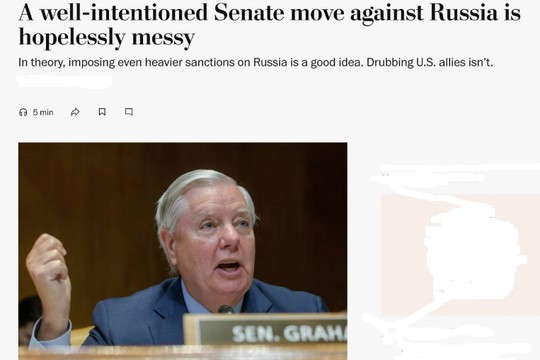Senator Graham’s bill also imposes a 500 percent tariff on any country that “knowingly sells, supplies, transfers, or purchases oil, uranium, natural gas, petroleum products, or petrochemical products that originated in the Russian Federation,” ‘The Washington Post’ notes.
A 500 percent tariff would essentially end U.S. trade with any of those countries. For perspective, the current highest enacted U.S. tariff on any country is the cumulative 55 percent tariffs on China. A punitive 500 percent tariff on countries trading with Russia might look good at first glance, but the first problem is that a lot of countries not considered U.S. enemies buy Russian crude oil. Yes, China imports the most, but a U.S. trade war with China is already underway. But India buys the second most, and Turkey, that often-difficult NATO ally, and the European Union are tied for the third most.
The European Union is taking steps to reduce its dependence on Russian energy exports. But, according to the Centre for Research on Energy and Clean Air, is the E.U.’s imports for Russian fossil fuels in 2024 were about $23 billion, which was higher than the over $19 billion in financial aid it gave to Ukraine. Yes, the Europeans put more money in Russia’s pocket last year than they did to support Ukraine.
The United States might want to pressure the Europeans to reduce their purchases of Russian energy faster, but virtually cutting off trade with Europe would be a harsh and self-destructive way to do it. Graham himself seems to recognize the geopolitical drawbacks to imposing a 500 percent tariff on America’s European allies, so he told ‘Semafor’ he has new suggestion: “Why don’t we carve out for countries who are helping Ukraine? If you’re providing military economic assistance to Ukraine, you get a carveout.”
Beyond Europe, South Korea and Taiwan buy Russian coal; Japan and South Korea buy Russia’s liquefied natural gas. Brazil is the third-biggest buyer of Russian oil products.
Enacting Graham’s bill would amount to enacting 500 percent tariffs on just about every major U.S. trading partner. Americans have already endured one short-lived trade war against the rest of the world this year — there isn’t an enormous appetite for another one.
Guess who else buys Russian energy in the form of enriched uranium? The United States of America, according to the pro-Kremlin outlet EADaily. According to the U.S. Energy Information Administration, in 2023, Russian-origin uranium material accounted for 12 percent of total deliveries to U.S., more than twice as much generated from the U.S., and Russia supplied 27 percent of the separative work units, a measurement of the effort required in the uranium enrichment process. Yes, last year President Joe Biden signed into law the Prohibiting Russian Uranium Imports Act, which theoretically banned the import of Russian uranium to run American nuclear reactors. But the law allows the Energy Department to issue waivers until 2028, and in February, Rosatom, Russia’s state nuclear power conglomerate, announced it had resumed exports to the United States.
Would the U.S. government enact a 500 percent tariff on itself? Wouldn’t the other countries America is punishing with 500 percent tariffs have a fair objection that they’re being harmed for importing energy products from Russia, when the United States itself is still importing energy products from Russia?
Graham’s bill has more than 80 co-sponsors — about four-fifths of the Senate clearly loves the idea of getting tougher on Russia. Less clear is whether the senators have thought through what the bill would actually do.
The comments on the proposed 500 percent tariff on countries trading with Russia, as suggested in Sen. Lindsey Graham's bill, express skepticism and criticism. Many commenters doubt the effectiveness and feasibility of the bill, citing potential economic repercussions.
read more in our Telegram-channel https://t.me/The_International_Affairs

 9:22 01.07.2025 •
9:22 01.07.2025 •























